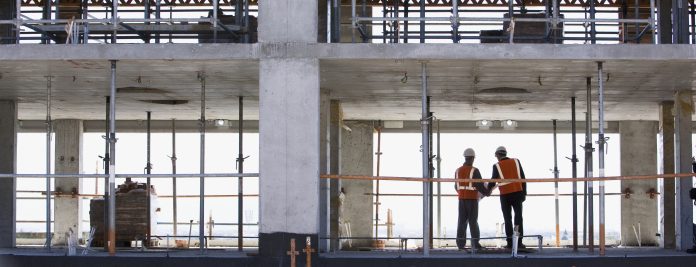PBC Today sat down with the interim chief executive of the Engineering Construction Industry Training Board (ECITB), Andy Brown, to discuss how collaboration can help the sector rise to the challenges it faces
Collaboration can help the construction sector to address the skills shortage through bringing diverse perspectives into the project process, improving and universalizing training standards and increasing efficiency across multiple industries, according to the ECITB’s Andy Brown.
In this interview with PBC Today, Andy reflected on how his 24 years in the Royal Air Force in technician and training roles led him to join the ECITB as a training development officer. Seventeen years and several operations roles later, he is serving as interim chief executive.
How does the ECITB support the industry?
Whilst most of the industrial training boards of the 1970s and 80s fell to the wayside under Conservative governments, “there were two industries that said, you can’t leave training to the market because there’s a market failure in training, because of the nature of the work. And that was the construction industry and the engineering construction industry.
“In 1991, the Engineering Construction Industry Training Board was set up to support training in the engineering construction industry. We gather about £28m in levy a year, and we aim to push as much of that back into the industry through training support. We support project management training, supervisory training, technical training, soft skills training, anything that supports the productivity of the engineering construction workforce, which is around about 90,000 people.”
The ECITB enjoys a positive collaborative relationship with the industry
“Although it’s mandated through the legal instruments, you still have to prove it’s a consensual levy, so the industry has to agree to pay it every three years. We develop our strategy with industry and once that strategy is agreed upon, we go out to the industry and consult on the levy to pay for the delivery of that strategy.
“We have to show [the Secretary of State] that more than 50% of the industry supports it and it represents more than 50% of the levy raised. Last year, 85% of the industry supported it and it represented 97% of the levy raised. So we got a massive mandate from our industry employers that the levy works; it works for them. “
The levy demonstrates that the industry is willing to invest in its people
“What it shows to me is it’s a little bit of a sort of contradiction, but the industrial training levy exists because there’s this so-called market failure in training in an industry that’s very contract and project driven. Here today, gone tomorrow, boom, bust, not investing significantly in your workforce because that workforce might go to another project tomorrow. So that theory holds up.
“But here’s an industry that actually is really invested in skills because 85% of it believe in paying into a collective pot that is a tax, and that represents 97% of the levy raised.
“So the vast majority of the industry believe that investing in skills in a collaborative manner is an effective way of doing it, but it’s also a strong endorsement of how the industry views its people.
Greater collaboration can protect SME project contractors and delivery
Traditional contracting methodology is often at the mercy of dozens of differing contractual demands, which places excessive pressure on smaller contractors facing tight margins and high risk.
“That contractor is not interested in that big picture that contracts. The contractor is interested in surviving. And the way to survive is potentially to disrupt, to delay, to be adversarial within this group of people that you’re trying to do this big piece of work with.
“I’m probably painting quite a dramatic picture, but actually, in lots of areas, it’s not that far from the truth. So a collaborative approach to projects aims to eliminate those risks of people behaving in an adversarial manner to the detriment of the project.”
“A collaborative approach gets everybody aligned to the main goals of the project. And the way you do that is through early supply chain engagement. Not running these series of hierarchical steps through the contracting chain, but just saying, ‘right, here we have got a major project. It will involve all of these component parts to deliver this project. What we’re going to do now is we’re going to go out to potential suppliers for all of those component parts and say this is what we want to achieve.’
“’Come and tell us how you do it and come to us with your solutions. And then once we have an idea on those solutions, we’ll come back out to you, and we will offer tenders to everybody to deliver these solutions.’ And that incentivizes a behaviour of people to start to work together.”
How collaboration in construction could be the answer to the skills shortage
Standardising training methods and qualifications are also a significant part of the ECITB’s aims.
“One of the issues around a skill shortage is that there’s a risk that less than competent people might be deployed to work on sites,” Andy continued.
“So the industry came together with us and said, ‘how can we connect competence across the industry?’ And we’ve been working on a programme called Connected Competence since then, and it’s now bearing fruit.
This is an approach that everybody signs up to a base level of technical capability. Everybody signs up. That’s what you need when you onboard one of these people. If we have the standardised approach, then Andy Brown can move to any contractor at any time and be deployed on any asset. Connected Competence is now endorsed by eleven asset owners in the North Sea, BP, CNOOC, many others to say ‘when we procure through our supply chains, we’re looking for you as a supplier to have your people tested against the connected competence standard’.
“If you start to over-specify on competence, you start to add cost. And if you add cost, that’s an inefficiency. They can see the benefits of taking out that inefficiency.”
Retention is just as important as recruitment
“If you don’t think about a more diverse workforce, all you’re going to do in a skill shortage situation, you’re going to try and get more out of the same pot that you’ve been recruiting from forever and a day. And that just doesn’t make sense. So you’ve got to broaden the diversity of the workforce.
“It isn’t just about women. It’s about going to those socioeconomic areas that hitherto industry hasn’t recruited from. We need to broaden the pipeline of people coming in and the diversity of those people- but we also need to make this industry a more inclusive place to work. Because as much as recruitment is an issue, retention is also an issue.
“There’s no point in bringing in a whole host of female graduates and going, hey, we’re ticking the diversity box if they’re in the industry for twelve months and then go and do something else. Every partner that we work with has got a focus on D&I. Offshore Energies UK, the Royal Academy of Engineering, the British Chemical Engineering Contractors Association, all organisations that we partner on issues with are all focusing on D&I. We’re focusing on D&I as a clear action within the next three years as part of our strategy.
“That will require an action plan and then that will require the delivery of that action plan. There are things that we are currently doing that can help deliver against that agenda.

“We are establishing new entrant pipelines in some areas of the country and we’re trialling those pipelines, working with local authorities to recruit from ex-offenders, low security prisons, where we can provide training and competence assurance testing and then onboard people to our contractors to work on the sites that we work with.
“We can encourage our employers to take on more women through their apprenticeship routes. I was in Scotland for Scottish Apprenticeship Week, and I was talking to two industry leaders, company leaders, about their female apprentices. And the feedback they’re getting is those apprentices are quite comfortable on the site working in the teams. There’s no negative feedback, it’s quite positive feedback. It will take a long time to purge all of these kind of behaviours that might put off people working on a site. But maybe change is coming.”
Getting the right people to advocate for change on every level
Innov8 is a group for young professionals in the engineering construction sector, representing the eight sectors that the ECITB works with.
“These are people who are in the early stages of their careers – graduates and apprentices. And they’re really keen on promoting the image of the industry. They are getting the message out around diversity and inclusivity through a series of blogs around diversity.
“Having young professionals who sit on this group actively talking about their experiences out in the public domain, all covered through LinkedIn and our social media network, carries more credibility than all of the, albeit important, discussions at senior levels in industry with people who look similar to me. So, we’ve got the right people being the advocates for the industry at the right level.”

















